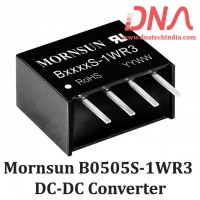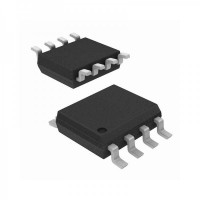The Inverting Amplifier |
||||
| We saw in the last tutorial that the Open Loop Gain, ( Avo ) of an ideal operational amplifier can be very high, as much as 1,000,000 (120dB) or more. However, this very high gain is of no real use to us as it makes the amplifier both unstable and hard to control as the smallest of input signals, just a few micro-volts, (μV) would be enough to cause the output voltage to saturate and swing towards one or the other of the voltage supply rails losing complete control of the output. | ||||
| As the open loop DC gain of an operational amplifier is extremely high we can therefore afford to lose some of this high gain by connecting a suitable resistor across the amplifier from the output terminal back to the inverting input terminal to both reduce and control the overall gain of the amplifier. This then produces and effect known commonly as Negative Feedback, and thus produces a very stable Operational Amplifier based system. | ||||
| Negative Feedback is the process of "feeding back" a fraction of the output signal back to the input, but to make the feedback negative, we must feed it back to the negative or "inverting input" terminal of the op-amp using an external Feedback Resistor called Rƒ. This feedback connection between the output and the inverting input terminal forces the differential input voltage towards zero. | ||||
| This effect produces a closed loop circuit to the amplifier resulting in the gain of the amplifier now being called its Closed-loop Gain. Then a closed-loop inverting amplifier uses negative feedback to accurately control the overall gain of the amplifier, but at a cost in the reduction of the amplifiers bandwidth. | ||||
| This negative feedback results in the inverting input terminal having a different signal on it than the actual input voltage as it will be the sum of the input voltage plus the negative feedback voltage giving it the label or term of a Summing Point. We must therefore separate the real input signal from the inverting input by using an Input Resistor, Rin. | ||||
| As we are not using the positive non-inverting input this is connected to a common ground or zero voltage terminal as shown below, but the effect of this closed loop feedback circuit results in the voltage potential at the inverting input being equal to that at the non-inverting input producing a Virtual Earth summing point because it will be at the same potential as the grounded reference input. In other words, the op-amp becomes a "differential amplifier". | ||||
Inverting Amplifier Configuration |
||||
|
|
||||
| In this Inverting Amplifier circuit the operational amplifier is connected with feedback to produce a closed loop operation. For ideal op-amps there are two very important rules to remember about inverting amplifiers, these are: "no current flows into the input terminal" and that "V1 equals V2", (in real world op-amps both of these rules are broken). | ||||
| This is because the junction of the input and feedback signal ( X ) is at the same potential as the positive ( + ) input which is at zero volts or ground then, the junction is a "Virtual Earth". Because of this virtual earth node the input resistance of the amplifier is equal to the value of the input resistor, Rin and the closed loop gain of the inverting amplifier can be set by the ratio of the two external resistors. | ||||
|
We said above that there are two very important rules to remember about Inverting Amplifiers or any operational amplifier for that matter and these are. 1. No Current Flows into the Input Terminals 2. The Differential Input Voltage is Zero as V1 = V2 = 0 (Virtual Earth) |
||||
| Then by using these two rules we can derive the equation for calculating the closed-loop gain of an inverting amplifier, using first principles. | ||||
| Current ( i ) flows through the resistor network as shown. | ||||
|
|
||||
|
|
||||
| Then, the Closed-Loop Voltage Gain of an Inverting Amplifier is given as. | ||||
|
|
||||
and this can be transposed to give Vout as: |
||||
|
|
||||
|
||||
Transresistance Amplifier Circuit |
||||
|
|
||||
| The simple light-activated circuit above, converts a current generated by the photo-diode into a voltage. The feedback resistor Rƒ sets the operating voltage point at the inverting input and controls the amount of output. The output voltage is given as Vout = Is x Rƒ. Therefore, the output voltage is proportional to the amount of input current generated by the photo-diode. | ||||
Example No1 |
||||
| Find the closed loop gain of the following inverting amplifier circuit. | ||||
|
|
||||
| Using the previously found formula for the gain of the circuit | ||||
|
|
||||
|
we can now substitute the values of the resistors in the circuit as follows, Rin = 10kΩ and Rƒ = 100kΩ. |
||||
| and the gain of the circuit is calculated as -Rƒ/Rin = 100k/10k = 10. | ||||
| therefore, the closed loop gain of the inverting amplifier circuit above is given 10 or 20dB (20log(10)). | ||||
Example No2 |
||||
| The gain of the original circuit is to be increased to 40 (32dB), find the new values of the resistors required. | ||||
|
Assume that the input resistor is to remain at the same value of 10KΩ, then by re-arranging the closed loop voltage gain formula we can find the new value required for the feedback resistor Rƒ. Gain = -Rƒ/Rin therefore, Rƒ = Gain x Rin Rƒ = 40 x 10,000 Rƒ = 400,000 or 400KΩ
|
||||
| The formula could also be rearranged to give a new value of Rin, keeping the same value of Rƒ. | ||||
| One final point to note about the Inverting Amplifier configuration for an operational amplifier, if the two resistors are of equal value, Rin = Rƒ then the gain of the amplifier will be -1 producing a complementary form of the input voltage at its output as Vout = -Vin. This type of inverting amplifier configuration is generally called a Unity Gain Inverter of simply an Inverting Buffer. | ||||
| In the next tutorial about Operational Amplifiers, we will analyse the complement of the Inverting Amplifier operational amplifier circuit called the Non-inverting Amplifier that produces an output signal which is "in-phase" with the input. | ||||
|












